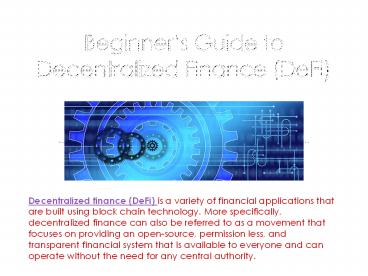Beginner’s Guide to Decentralized Finance (DeFi) - PowerPoint PPT Presentation
Title:
Beginner’s Guide to Decentralized Finance (DeFi)
Description:
Decentralized finance (DeFi) is a variety of financial applications that are built using blockchain technology. More specifically, decentralized finance can also be referred to as a movement that focuses on providing an open-source, permissionless, and transparent financial system that is available to everyone and can operate without the need for any central authority. – PowerPoint PPT presentation
Number of Views:868
Title: Beginner’s Guide to Decentralized Finance (DeFi)
1
Beginners Guide to Decentralized Finance (DeFi)
Decentralized finance (DeFi) is a variety of
financial applications that are built using block
chain technology. More specifically,
decentralized finance can also be referred to as
a movement that focuses on providing an
open-source, permission less, and transparent
financial system that is available to everyone
and can operate without the need for any central
authority.
2
What are the main advantages of decentralized
finance?
- With traditional finance, users rely on
centralized institutions such as banks to act as
intermediaries when using financial services.
DeFi applications do not use any intermediaries.
The apps are able to resolve every possible
dispute, which makes users have control over
their funds at all times. Because of this, the
costs associated with providing and using these
products are reduced, which allows for a more
frictionless financial system. Since these new
financial services are created on the blockchain,
single points of failure are eliminated. All the
data is recorded on the blockchain and sent to
different nodes, making it hard to potentially
shut down a service or hack a system. The
frameworks for DeFi applications are built in
advance, thats why deploying one becomes less
complicated but more secure.
3
- Another crucial advantage of an open system is
its accessibility allowing individuals who dont
have access to any financial service to have
access to it. Because the traditional financial
system relies on the intermediaries making a
profit, they dont usually offer their services
on locations with low-income communities. With
the use of decentralized finance, the costs of
financial services are significantly reduced,
creating access to low-income individuals
allowing them to benefit from a broader range of
financial services. With DeFi, users can have
full control over their assets and interact with
the system through peer-to-peer (P2P) and
decentralized applications (dApps). The core
feature of decentralized finance is its
accessibility, even to those who are isolated by
the current financial system. Another benefit of
DeFi is the modular framework it is built upon.
These interoperable DeFi applications on public
block chains will potentially create new
financial markets, services, and products.
4
What are the main advantages of decentralized
finance?
- With traditional finance, users rely on
centralized institutions such as banks to act as
intermediaries when using financial services.
DeFi applications do not use any intermediaries.
The apps are able to resolve every possible
dispute, which makes users have control over
their funds at all times. Because of this, the
costs associated with providing and using these
products are reduced, which allows for a more
frictionless financial system. Since these new
financial services are created on the block
chain, single points of failure are eliminated.
All the data is recorded on the block chain and
sent to different nodes, making it hard to
potentially shut down a service or hack a system.
The frameworks for DeFi applications are built in
advance, thats why deploying one becomes less
complicated but more secure.
5
- Another crucial advantage of an open system
is its accessibility allowing individuals who
dont have access to any financial service to
have access to it. Because the traditional
financial system relies on the intermediaries
making a profit, they dont usually offer their
services on locations with low-income
communities. With the use of decentralized
finance, the costs of financial services are
significantly reduced, creating access to
low-income individuals allowing them to benefit
from a broader range of financial services.
6
The potential use cases of decentralized finance
- There are several use cases of decentralized
finance. Here are some of them - Cryptocurrency
- According to a report published by Jenco, a
decentralized financial service platform,
digital assets, usually in the form of
cryptocurrencies like BitCoin and Ethereum, are
used by computer networks all over the world.
These digital assets are made secure by using a
method called cryptography that prevents
double-spending and counterfeiting.The
blockchain, a ledger that is distributed and
enforced by a separate web of computers,
guarantees these cryptocurrencies integrity. One
of the most distinctive traits of these digital
assets is that they are not and can not be
manipulated or controlled by any centralized
authority.
7
Borrowing and Lending
- Open lending protocols, such as Jenco, are
one of the most popular types of applications
that are offered in the decentralized finance
system. There are many advantages of an open,
decentralized borrowing, and lending over the
traditional credit system. These advantages
include no credit checks, the ability to
collateralize digital assets, instant settlement
of transactions, and potential standardization in
the future. These lending services are built on
public blockchains, they reduce the amount of
trust needed and have the assurance of
cryptographic verification methods. Lending
applications on the blockchain reduces
counterparty risk, makes borrowing and lending
faster, cheaper and accessible to more people.
Conclusion
There are other potential use cases of DeFi, but
the most widely used ones are the one mentioned
above. Decentralized finance is focused on
building financial services separate from the
traditional centralized systems. As a result,
there will be a more open financial system in the
future that could potentially prevent censorship
and financial discrimination all over the world.



















![Decentralised Finance [DeFi] Growth in 2021 PowerPoint PPT Presentation](https://s3.amazonaws.com/images.powershow.com/9620252.th0.jpg?_=202106250611)











